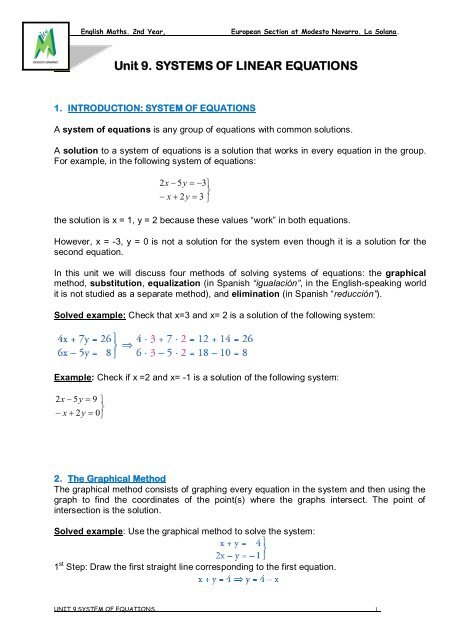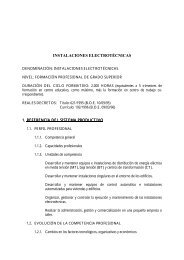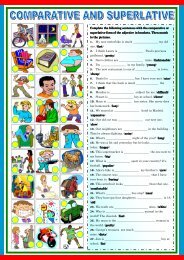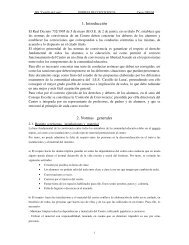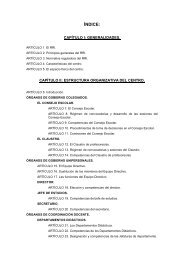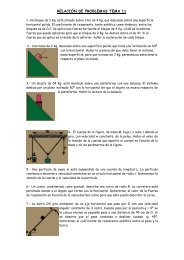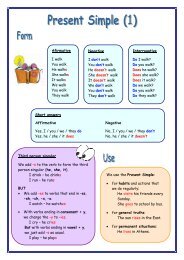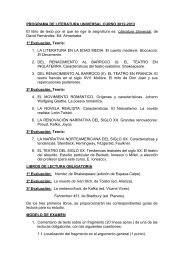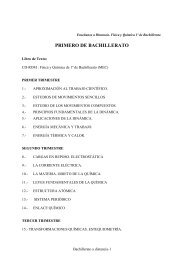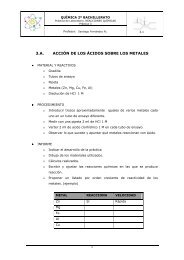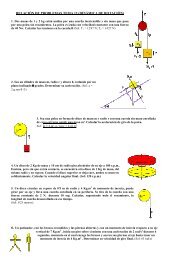Classnotes
Classnotes
Classnotes
Create successful ePaper yourself
Turn your PDF publications into a flip-book with our unique Google optimized e-Paper software.
English Maths. 2nd Year, European Section at Modesto Navarro. La Solana.<br />
Unit 9. SYSTEMS OF LINEAR EQUATIONS<br />
1. INTRODUCTION: SYSTEM OF EQUATIONS<br />
A system of equations is any group of equations with common solutions.<br />
A solution to a system of equations is a solution that works in every equation in the group.<br />
For example, in the following system of equations:<br />
2x<br />
x<br />
5y<br />
2y<br />
3<br />
3<br />
the solution is x = 1, y = 2 because these values “work” in both equations.<br />
However, x = -3, y = 0 is not a solution for the system even though it is a solution for the<br />
second equation.<br />
In this unit we will discuss four methods of solving systems of equations: the graphical<br />
method, substitution, equalization (in Spanish “igualación”, in the English-speaking world<br />
it is not studied as a separate method), and elimination (in Spanish “reducción”).<br />
Solved example: Check that x=3 and x= 2 is a solution of the following system:<br />
Example: Check if x =2 and x= -1 is a solution of the following system:<br />
2x<br />
x<br />
5y<br />
2y<br />
9<br />
0<br />
2. The Graphical Method<br />
The graphical method consists of graphing every equation in the system and then using the<br />
graph to find the coordinates of the point(s) where the graphs intersect. The point of<br />
intersection is the solution.<br />
Solved example: Use the graphical method to solve the system:<br />
1 st Step: Draw the first straight line corresponding to the first equation.<br />
UNIT 9.SYSTEM OF EQUATIONS.. 1
English Maths. 2nd Year, European Section at Modesto Navarro. La Solana.<br />
2 nd Step: Draw the second straight line corresponding second equation.<br />
3th Step: The solution is the point of intersection of these straight lines: x = 1, y = 3.<br />
Example: Use the graphical method to solve the following system of equations..<br />
x y 2<br />
2x<br />
y 3<br />
Note: Carefully graph both equations very precisely. If you don’t graph neatly, your point of<br />
intersection will be way off.<br />
: Draw “x” and “y” axes.<br />
Graph the first equation, it’s a straight line: x-y = -2<br />
UNIT 9.SYSTEM OF EQUATIONS.. 2
English Maths. 2nd Year, European Section at Modesto Navarro. La Solana.<br />
Graph the second equation, it’s another straight line: -2x + y = 3<br />
The solution is the point of intersection.<br />
Example: Use the graphic method to solve the following system of linear equations:<br />
2x<br />
y 4<br />
NUMBER OF SOLUTIONS IN A SYSTEM OF EQUATIONS:<br />
A system of equations can be classified according to the number of solutions:<br />
UNIT 9.SYSTEM OF EQUATIONS.. 3<br />
x<br />
y<br />
Compatible system: if the system has got one solution, then the straight<br />
lines cut across each other in one point. Example:<br />
1
English Maths. 2nd Year, European Section at Modesto Navarro. La Solana.<br />
Incompatible system: if the system hasn’t got a solution, then the straight<br />
lines are parallel. Example:<br />
Example: Look at these graphics and write the solutions of these systems of equations:<br />
a) b)<br />
SOLUTION:_______________ SOLUTION: __________________<br />
TO REVISE THIS THEORY, YOU CAN VISIT THIS USEFUL AND ENJOYABLE WEBSITE, WHERE YOU<br />
CAN WATCH SOME VIDEOS. COME ON, GIVE IT A TRY!<br />
http://www.math-videos-online.com/systems-of-equations.html<br />
Exercise 1. Solve the following systems using the graphic method. Decide if they are<br />
compatible or incompatible:<br />
UNIT 9.SYSTEM OF EQUATIONS.. 4
English Maths. 2nd Year, European Section at Modesto Navarro. La Solana.<br />
Exercise 2. The addition of two numbers is equal to 5. Write an equation expressing this<br />
condition and calculate five pairs of solutions. Draw this set of solutions.<br />
Exercise 3. The subtraction of two numbers is 1. Write an equation expressing this<br />
condition and calculate five pairs of solutions. Draw the set of equations.<br />
UNIT 9.SYSTEM OF EQUATIONS.. 5
English Maths. 2nd Year, European Section at Modesto Navarro. La Solana.<br />
Exercise 4. Solve the following system of equations using the graphic method:<br />
3. Substitution Method<br />
The method of solving "by substitution" works by solving one of the equations (you choose<br />
which one) for one of the variables (you choose which one), and then using this (or plugging<br />
this back) in the other equation, "substituting" it for the chosen variable and solving the<br />
other. When you know the value of the second variable, you can easily calculate the first<br />
variable (back-solve for it).<br />
Here is how it works. (We'll use the same systems that we used in the previous pages.)<br />
Solved example: (substitution method)<br />
The idea here is to solve one of the equations for one of the variables, and<br />
replace that variable with this in the other equation (plug it in the other equation). It<br />
does not matter which equation or which variable you choose. There is no right or<br />
wrong choice; the answer will be the same either way. However, some choices may<br />
make the calculations easier than others.<br />
For instance, in this case, we can see that the simplest way is probably to solve the<br />
second equation for "y =", since there is already an isolated y in the middle of the equation:<br />
y 24 4x<br />
UNIT 9.SYSTEM OF EQUATIONS.. 6<br />
2x<br />
4x<br />
3y<br />
We could also solve x , but we would get fractions:<br />
x<br />
24 y<br />
4<br />
Solving the first equation for either variable would also give me fractions. It wouldn't<br />
be "wrong" to make a different choice, but it would probably be more difficult. So it is easier<br />
to solve the second equation for y:<br />
1 st step: Work out the value of “y” in the second equation (because it’s the easiest one)<br />
2x<br />
3y<br />
2<br />
y<br />
24<br />
4x<br />
2 nd step: Now plug this into the first equation (substitute it for y in the first equation), and<br />
solve it for x:<br />
y<br />
24<br />
2
English Maths. 2nd Year, European Section at Modesto Navarro. La Solana.<br />
2x – 3(–4x + 24) = –2<br />
2x + 12x – 72 = –2<br />
14x = 70<br />
x = 5<br />
3 rd step: Calculate the value of the other unknown. We can plug this x-value into either<br />
equation, and solve for y, but since we already have an expression for "y =", the simplest<br />
solution is to just plug it in there:<br />
y = 24 – 4x<br />
y = 24 – 4(5) = 24 – 20 = 4<br />
Then the solution is (x, y) = (5, 4).<br />
Warning: If you substitute the "24 – 4x" expression into the same equation that you have<br />
used to solve for "y =", you get a true, but useless, statement:<br />
4x + (–4x + 24) = 24<br />
4x – 4x + 24 = 24<br />
24 = 24<br />
It is true that twenty-four equals twenty-four, but that doesn’t help us. So when using<br />
substitution, make sure you substitute into the other equation, or you'll just be wasting your<br />
time.<br />
Solved examples. Visit these webpages to watch some videos which revise the<br />
substitution method:<br />
http://video.google.com/videoplay?docid=-6836161716522364284#<br />
http://www.ehow.com/video_4754360_solve-equations-substitution.html<br />
Exercise 5. Solve the following system using the substitution method. Write if it is<br />
compatible or incompatible:<br />
a)<br />
b)<br />
UNIT 9.SYSTEM OF EQUATIONS.. 7
c)<br />
d)<br />
English Maths. 2nd Year, European Section at Modesto Navarro. La Solana.<br />
UNIT 9.SYSTEM OF EQUATIONS.. 8
English Maths. 2nd Year, European Section at Modesto Navarro. La Solana.<br />
4. “Equalization” Method.<br />
This method consists in:<br />
1 st step: Work out the value of the same variable in both equations. (You choose the<br />
variable)<br />
2 nd step: Make both expressions equal.<br />
3th step: Solve this equation.<br />
4 th step: To calculate the value of the other variable, plug the first back into one of the<br />
equations, "substituting".<br />
Example: Solve using the Equalization Method:<br />
Solution:<br />
Exercise 6. Solve using the Equalization Method.<br />
a)<br />
b)<br />
UNIT 9.SYSTEM OF EQUATIONS.. 9
English Maths. 2nd Year, European Section at Modesto Navarro. La Solana.<br />
5. Elimination or addition method.<br />
To learn the procedure to solve a system of equations using the elimination<br />
method, please visit these videos in the following websites:<br />
http://www.youtube.com/watch?v=xB-oXaCoJoc<br />
http://www.youtube.com/watch?v=ej25myhYcSg<br />
Solved example: Solve the system of linear equations.<br />
multiply all the terms in the second equation by 3<br />
-2x + 3y = 8<br />
9x - 3y = -15<br />
add the two equations (you can also subtract them if it is easier)<br />
7x = -7<br />
Note: y has been eliminated, hence the name: method of elimination. Now solve the<br />
above equation for x:<br />
x = -1<br />
replace x with -1 in the first equation:<br />
-2(-1) + 3y = 8<br />
solve the above equation for y:<br />
2 + 3y = 8<br />
3y = 6<br />
y = 2<br />
write the solution to the system as an ordered pair:<br />
(-1,2)<br />
check the solution obtained:<br />
first equation: Left Side: -2(-1) + 3(2)= 2 + 6 = 8<br />
Right Side: 8<br />
second equation: Left Side: 3(-1)-(2)=-3-2=-5<br />
Right Side: -5<br />
UNIT 9.SYSTEM OF EQUATIONS.. 10<br />
3x<br />
2x<br />
y<br />
3y<br />
5<br />
8
English Maths. 2nd Year, European Section at Modesto Navarro. La Solana.<br />
conclusion: The given system of equations is consistent, and it has the ordered pair<br />
which is shown below as a solution.<br />
(-1,2)<br />
Exercise 6. Solve the following systems using the most suitable method and classify<br />
them:<br />
a)<br />
b)<br />
c)<br />
d)<br />
e)<br />
UNIT 9.SYSTEM OF EQUATIONS.. 11
f)<br />
English Maths. 2nd Year, European Section at Modesto Navarro. La Solana.<br />
NOTE: if you want to practise more, you can visit this website on the Internet:<br />
http://www.emathematics.net/sistecuaciones.php?ejercicio=simple&def=find<br />
UNIT 9.SYSTEM OF EQUATIONS.. 12
English Maths. 2nd Year, European Section at Modesto Navarro. La Solana.<br />
6.PROBLEMS WITH SYSTEMS OF EQUATIONS.<br />
Exercises: Page 178, exercises: 65, 66, 67, 68, 69, 70, 71, 72, 73, 74, 75, 76.<br />
Exercise 7. The admission fee at a museum fair is $1.50 for children and $4.00 for adults.<br />
On a certain day, 2,200 people visit the museum, and they pay a total of $5,050. How many<br />
children and how many adults visited the museum?<br />
Exercise 8. The air-mail rate for letters to Europe is 45 cents per half-ounce, and to Africa it<br />
is 65 cents per half-ounce. If Shirley paid $18.55 to send 35 half-ounce letters abroad, how<br />
many did she send to Africa?<br />
UNIT 9.SYSTEM OF EQUATIONS.. 13


